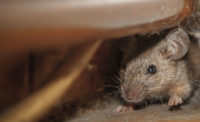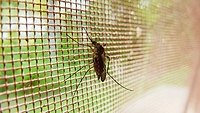“Waiter! There’s a Fly in My Soup!”…and So Much More

Many people have found a fly in their soup. However, what few realize is that there is so much more in the bowl and on the dinner plate.
There are grain insect fragments in pasta. Tomatoes used to make soup have rot fragments. Broccoli is loaded with thrips, aphids and their body parts. Rice can be crawling with Indian meal moth caterpillars. Allergenic mites cling on fish. Even seasonings used to flavor food can contain cigarette beetle larva, scale insects and pieces of rodent feces.
The presence of these pests, their body parts or their excrement in food is repugnant to most and may be a health hazard, but human foods are attractive to a wide variety of animals, as competition for nutritive substances is keen and continuous, and food pests take advantage of every opportunity to convert human food to their own use. All edible portions of field and orchard crops are affected by an assortment of pests. After the crop is harvested and started through some sort of processing, it encounters two classes of pests: those associated mainly with the food itself and those associated with buildings.
The scientific discipline concerned with the isolation, detection and identification of these “filth elements” is microanalytical entomology.
A Little History
The U.S. Pure Food and Drug Act of 1906 marks the beginning of the development of microanalytical entomology. During this era, food adulterants were studied by the same analysts who performed the microchemical testing of drugs as well as other analyses that required the use of a microscope. This discipline grew out of the need for some microscopists to specialize in examinations for animal and insect adulteration.
In 1938, the Federal Food, Drug and Cosmetic Act replaced earlier federal statutes. This landmark legislation defined two types of adulteration that relate to microanalytical entomology: Section 402 (a) (3) states that a food shall be deemed to be adulterated if it consists in whole or in part of any filthy, putrid or decomposed substance, or if it is otherwise unfit for food; Section 402 (a) (4) states that it is adulterated if it has been prepared, packaged or held under insanitary conditions whereby it may have become contaminated with filth, or whereby it may have been rendered injurious to health.
This legislation increased the emphasis on detection and prevention of pest-related insanitation by encouraging inspections of food processing, packing and storage establishments for pest infestations and by increasing the need for more sophisticated levels of entomological identification. Microanalytical entomology emerged as a distinct scientific discipline shortly after the enactment of this legislation. In practice, it is the forensic scientific examination of foods, drugs and cosmetics for contamination with filth from insects or other pests and the detection of filthy conditions involving these pests in factories, warehouses and other places where these products are manufactured, processed, packed or stored.
Challenges to Analyses
Any laboratory specializing in this field faces several challenges when presented with a product for filth analysis. The first challenge is deciding whether to do a macroscopic or a microscopic procedure. A macroscopic analysis is chosen if the product is unprocessed and whole and if the filth elements present in the product are visible to the naked eye. These filth elements include live or dead insects, rodent pellets, dung, bird droppings and insect excreta. A microscopic analysis is chosen if the product is further processed and the filth elements are small and obscured by the product. These filth elements include whole/equivalent insects, insect fragments, mites, animal hairs and feather parts. Sometimes both types of analyses may be required.
The second challenge is if a microscopic analysis is to be performed, the ingredient statement must be looked at to see what methodologies will be employed. The main objectives of the method chosen are to recover as many of the filth elements in the product as possible and to leave behind the majority of the product. The method chosen can be divided into three distinct activities: pretreatment, extraction and recovery. Pretreatment is the preparation of the product for extraction. The extraction is the separation of an oil phase from an aqueous phase (light filth elements associate with the oil phase). The recovery step is where isolated filth elements are placed onto filter paper for further microscopic examination.
Where internal filth is a concern, the product must be broken down to simpler components, thus freeing the filth elements. Sometimes, an acid digestion must be used. For external filth, a relatively uncomplicated method can be developed, provided that the product can be easily mixed with an appropriate reagent and dispersed in a suitable extraction vessel. Dispersions are usually accomplished in water or in an alcohol-water combination. If the product contains internal or external oil, it must be defatted to remove the interfering substance. Wet sieving, which removes water-soluble components and any added reagents, can reduce the amount of product to be analyzed. Boiling the remaining residue will remove any trapped air that would have made the residue buoyant. Sometimes, even after boiling, considerable residue is still floating. Cooling it rapidly to room temperature in a water bath will cause the material to sink, or a sequestering agent can be added to suppress the residue further. Stirring oil into the aqueous phase is a crucial step. If it is not done properly, the residue does not settle out and all the previous procedures are negated. The oil is floated off, isolated and finally placed onto ruled filter paper.
The final and most critical challenge is having a thoroughly trained microscopist who can both quantify and, most importantly, identify any isolated filth elements.
The analysis of a product for filth is incomplete if the analyst does not distinguish between kinds of filth contaminants by determining their scientific names or identities. Filth element identification has become increasingly important in sanitation analyses as it serves as a guide to the etiology of contamination in a manner that nonspecific counting of filth elements cannot duplicate.
When the etiology of contamination is understood, the value of the analysis is immeasurably increased since laboratory clues can be interpreted in terms of breakdowns in the sanitation of raw materials and in the manufacturing or handling facilities. As a forensic scientist, the microanalytical entomologist helps determine whether the “crime” of adulteration has been committed and, if so, develops evidence that helps establish the guilt or innocence of suspects. What sets microanalytical entomology apart from other disciplines of entomology is its emphasis on the identification of filth elements, the interpretation of the sanitary significance of filth in food and the detection of postharvest adulteration that may occur during the manufacture, packing or warehousing of food.
Assignment of Risk
Filth and extraneous materials found can be grouped into three risk categories. Category 1 includes vectors of foodborne pathogens regardless of whether a microbiological hazard is detected. These contaminants are associated with a potential hazard to health and are of the highest concern to consumers, food processors and food regulators. Pests in this category include the housefly, German cockroach, pharaoh ant and house mouse.
Category 2 includes pests whose presence in or near food processing or storage areas is an indication of unsanitary conditions. Pests in this category are of serious concern to consumers, food processors and food regulators, and include birds, bats, lizards, storage insects and grain mites.
Category 3 includes agricultural pests, nuisance pests and other incidental pests. These are natural or unavoidable contaminants that pose no hazard to health and are natural or unavoidable, to a degree, in rural environments where food crops are grown and harvested. Category 3 contaminants are an area of concern over the quality of the food that enters the marketplace.
Summary
As can be seen, correct identification of contaminants found in food is critical and essential to proper risk assessment. The simple counting of isolated filth is insufficient. Therefore, it is essential that any laboratory performing filth analyses have a thoroughly trained microscopist expert in the field of microanalytical entomology.
The next time you are in a restaurant and hear somebody exclaim, “Waiter! There’s a fly in my soup,” this analyst would say, “Ah, yes! But what type of fly?”
Richard Haynos is manager and lead microscopist for the Food Forensics Department of Certified Laboratories of Plainview, NY.
Resources
Gentry, J.W. and K.L. Harris. 1991. Microanalytical entomology for food sanitation control, 2nd ed. Arlington, VA: AOAC International.
Gorham, J.R., ed. 1981. Principles of food analysis for filth, decomposition and foreign matter, 2nd ed. FDA Tech. Bull. No. 1. Washington, DC: U.S. Food and Drug Administration.
Looking for a reprint of this article?
From high-res PDFs to custom plaques, order your copy today!




